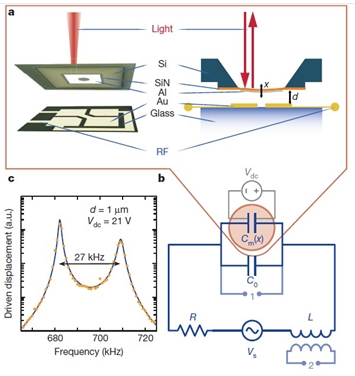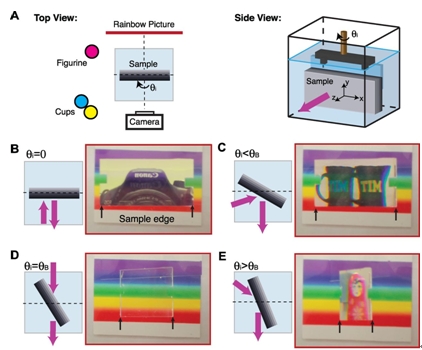1.通过纳米机械传感器对无线电波进行光电探测(Optical detection of radio waves through a nanomechanical transducer)【Nature】
doi:10.1038/nature13029
published:2014.3.5
内容介绍:
对微弱的无线电波信号进行低损耗的传输和高灵敏度还原是一项富具挑战的工作,特别是在射电天文学、医学成像、航海以及量子通讯等领域。将射频信号加载到光学载波上,并通过光纤传输信号,可以极大改善铜线传输中的损耗问题,并且可以很方便地集合现有的量子光学技术,实现量子极限信号检测。在腔洞光力学中的研究已经表明,纳米机械振荡器可以很好地应用于微波和光波领域。本文展示了一款在室温下工作的光电子机械传感器,它具备了上述特点,并使用了一款最近报道过的高质量的纳米膜。一个小于10V的偏置电压就足够使射频谐振电路的电压波动和纳米膜位移之间产生强耦合。一束光经过纳米膜表面反射,通过测量光学相位变化,就可以对射频信号实现量子极限灵敏度的检测。相应的半波电压在微伏量级,小于标准的光调制器。传感器的噪声主要由光量子噪声和纳米膜的热振动噪声构成。

图一 机械系统 a纳米膜结构b纳米膜构成的电容器是LC电路的一部分c在纳米膜和射频信号间存在强耦合

图二 耦合度分析
doi:10.1126/science.1249799
published:2014.3.28
内容介绍:
一个单色的电磁平面波主要有三个特性:频率,偏振,以及传播方向。通过前两个特性进行光选择已经有了深入的研究,通过第三个特性进行光选择则很少有所报道,但却是同样重要的。本文展示了一种通过传播角度进行光选择的方法。该方法中异质结光子晶体在特定的小角度上是透明的,这个角度是广义布鲁斯特角,而在其他角度是光全反射的。这种通过传播角度进行光选择的方法在很多方面将有用武之地,比如太阳能的高效率转换、隐私保护系统以及高信噪比探测器等。

图一 通过传播角度进行光选择的理论分析示意

图二 实验装置和实验结果 a、实验装置图;b、0度角入射时晶体表现为平面镜;c、30度角入射时晶体表现为平面镜;d、55度角(布鲁斯特角)入射时晶体透明;e、70度角入射时晶体表现为平面镜
二、简讯:
doi:10.1038/nphoton.2014.47
published:2014.3.23
Abstract:
Plasma channels produced in air through femtosecond laser filamentation hold great promise for a number of applications, including remote sensing, attosecond physics and spectroscopy, channelling microwaves and lightning protection. In such settings, extended filaments are desirable, yet their longitudinal span is limited by dissipative processes. Although various techniques aiming to prolong this process have been explored, the substantial extension of optical filaments remains a challenge. Here, we experimentally demonstrate that the natural range of a plasma column can be enhanced by at least an order of magnitude when the filament is prudently accompanied by an auxiliary beam. In this arrangement, the secondary low-intensity ‘dressing’ beam propagates linearly and acts as a distributed energy reservoir, continuously refuelling the optical filament. Our approach offers an efficient and viable route towards the generation of extended light strings in air without inducing premature wave collapse or an undesirable beam break-up into multiple filaments.
doi:10.1021/nl403909r
published:2013.11.25
Abstract:
Si nanowires (NWs) have been widely explored as a platform for photonic and electronic technologies. Here, we report a bottom-up method to break the conventional “wire” symmetry and synthetically encode a high-resolution array of arbitrary shapes, including nanorods, sinusoids, bowties, tapers, nanogaps, and gratings, along the NW growth axis. Rapid modulation of phosphorus doping combined with selective wet-chemical etching enabled morphological features as small as 10 nm to be patterned over wires more than 50 μm in length. This capability fundamentally expands the set of technologies that can be realized with Si NWs, and as proof-of-concept, we demonstrate two distinct applications. First, nanogap-encoded NWs were used as templates for Noble metals, yielding plasmonic structures with tunable resonances for surface-enhanced Raman imaging. Second, core/shell Si/SiO2 nanorods were integrated into electronic devices that exhibit resistive switching, enabling nonvolatile memory storage. Moving beyond these initial examples, we envision this method will become a generic route to encode new functionality in semiconductor NWs.
doi: 10.1364/OL.39.002194r
published:2014.3.21
Abstract:
We experimentally demonstrated a free spectrum range (FSR) tunable comb filter based on a programmable thermo-controlled Mach–Zehnder interferometer. The device is constructed by sandwiching a length of ethanol-filled photonic crystal fiber between single-mode fibers. A digital thermal printer head is used to facilitate the interference as well as to adjust the phase difference by selectively activating the independent heating elements, thus the FSR can be digitally tuned conveniently. The filter shows a feature of periodic equalized passbands with flat-top steep-edge as well as a high extinction ratio over a very wide range of wavelengths from 1.52 to 1.58 μm.
doi:10.1364/OE.22.008035
published:2014.3.28
Abstract:
Presbyopia, the age-related reduction in near vision acuity, is one of the leading issues facing the contact lens industry due to an increasingly ageing population and limitations associated with existing designs. A plastic-based liquid crystal contact lens is described which is designed to allow switchable vision correction. The device is characterized by low operating voltages (<5Vrms) and has curvatures suitable for placement upon the cornea. Imaging and Point Spread Function analysis confirm that the lens provides an increase in optical power of + 2.00 ± 0.25 D when activated, ideal for presbyopia correction.
供稿:倪秧







